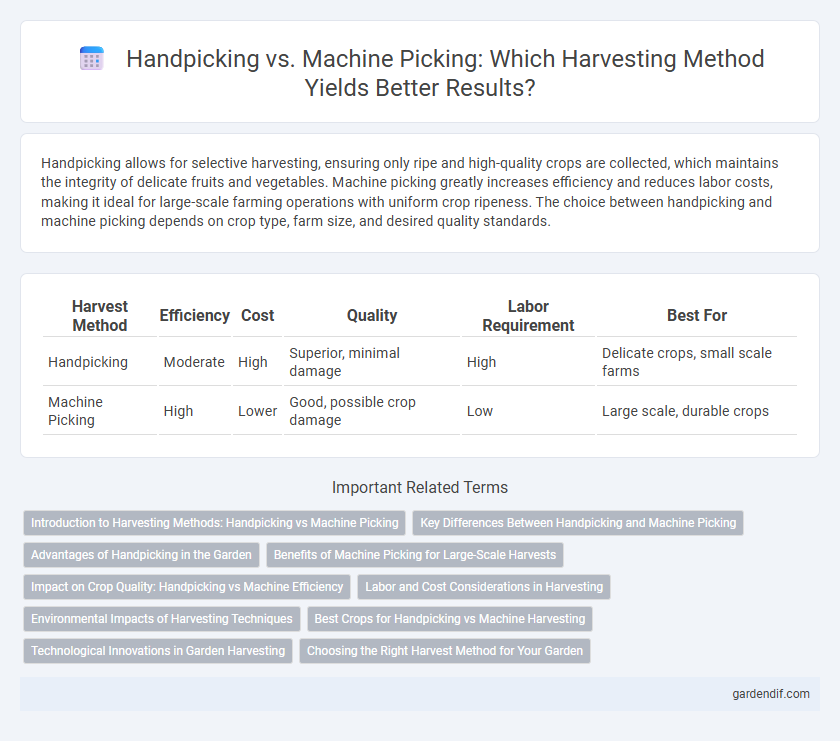
Handpicking vs Machine Picking Illustration
Handpicking allows for selective harvesting, ensuring only ripe and high-quality crops are collected, which maintains the integrity of delicate fruits and vegetables. Machine picking greatly increases efficiency and reduces labor costs, making it ideal for large-scale farming operations with uniform crop ripeness. The choice between handpicking and machine picking depends on crop type, farm size, and desired quality standards.
Table of Comparison
| Harvest Method | Efficiency | Cost | Quality | Labor Requirement | Best For |
|---|---|---|---|---|---|
| Handpicking | Moderate | High | Superior, minimal damage | High | Delicate crops, small scale farms |
| Machine Picking | High | Lower | Good, possible crop damage | Low | Large scale, durable crops |
Introduction to Harvesting Methods: Handpicking vs Machine Picking
Handpicking offers precise fruit selection, minimizing damage and preserving quality, particularly for delicate crops such as berries and grapes. Machine picking enhances efficiency and reduces labor costs, ideal for large-scale farms harvesting durable produce like apples and citrus. Choosing between handpicking and machine picking depends on factors including crop type, scale of operation, and desired product quality.
Key Differences Between Handpicking and Machine Picking
Handpicking allows for selective harvesting, ensuring only ripe and high-quality crops are picked, which reduces damage and maintains product integrity. Machine picking offers high efficiency and speed, suitable for large-scale farms but may cause more bruising and less selectivity. The key differences lie in precision, labor intensity, and impact on crop quality, with handpicking favored for delicate produce and machine picking for bulk harvesting.
Advantages of Handpicking in the Garden
Handpicking in the garden allows for precise selection of ripe fruits and vegetables, minimizing damage and ensuring higher quality produce. It enables gardeners to avoid unripe or pest-infested items, preserving the overall health of the crop. This method supports sustainable harvesting practices by reducing waste and promoting careful handling of plants.
Benefits of Machine Picking for Large-Scale Harvests
Machine picking significantly increases harvest efficiency by rapidly collecting crops from extensive fields, reducing labor costs and time compared to handpicking. The use of advanced mechanical harvesters ensures consistent crop quality and minimizes losses through precision technology and adjustable settings tailored to different crop types. Large-scale operations benefit from scalable machinery that accommodates high volumes, supporting timely harvests and maintaining market supply demands.
Impact on Crop Quality: Handpicking vs Machine Efficiency
Handpicking allows for selective harvesting, ensuring only ripe produce is gathered, which enhances overall crop quality by reducing damage and contamination. Machine picking significantly increases efficiency by harvesting large areas quickly but may cause bruising or collect unripe or damaged crops, potentially lowering quality. Balancing handpicking and machine methods optimizes both the quality and quantity of the harvest.
Labor and Cost Considerations in Harvesting
Handpicking in harvesting demands significant labor, increasing operational costs due to the need for skilled workers and extended harvest times, especially for delicate crops like fruits and vegetables. Machine picking reduces labor requirements substantially but involves high upfront investment and maintenance expenses while potentially compromising crop quality through mechanical damage. Balancing labor availability, cost efficiency, and crop sensitivity is essential for optimizing harvesting strategies in agricultural production.
Environmental Impacts of Harvesting Techniques
Handpicking minimizes soil compaction and reduces damage to surrounding vegetation compared to machine picking, which often involves heavy machinery that disrupts soil structure and increases erosion risks. Manual harvesting supports biodiversity by preserving insect habitats and limiting carbon emissions associated with fuel-powered equipment. Sustainable handpicking practices contribute to maintaining ecosystem balance and reducing the environmental footprint of agricultural operations.
Best Crops for Handpicking vs Machine Harvesting
Handpicking is ideal for delicate crops such as strawberries, grapes, and tea leaves, where precision and minimal damage are crucial for maintaining quality and flavor. Machine harvesting suits robust crops like wheat, corn, and potatoes, enabling efficient large-scale collection with reduced labor costs. Factors including crop fragility, terrain, and harvest timing determine the optimal method, balancing yield and quality.
Technological Innovations in Garden Harvesting
Technological innovations in garden harvesting have revolutionized the traditional handpicking process by introducing advanced machinery that enhances efficiency and reduces labor costs. Modern harvesters equipped with AI-powered sensors and robotic arms selectively pick ripe produce, minimizing damage and improving quality. These innovations not only increase yield but also enable real-time monitoring and data analytics for optimized crop management.
Choosing the Right Harvest Method for Your Garden
Handpicking fruits and vegetables allows for gentle handling, minimizing bruising and ensuring only ripe produce is selected, making it ideal for delicate crops like berries and tomatoes. Machine picking offers efficiency and speed, suitable for larger gardens and crops such as apples, grapes, and potatoes, but may cause damage to softer fruits. Gardeners should evaluate crop type, scale, and desired quality to choose the optimal harvest method that balances labor, cost, and produce integrity.
Handpicking vs Machine Picking Infographic

 gardendif.com
gardendif.com